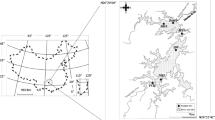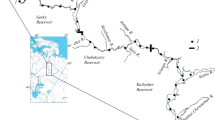Abstract
Eutrophication and harmful algal blooms have become a worldwide environmental problem. Understanding the mechanisms and processes that control algal blooms is of great concern. The phytoplankton community of Karaoun Reservoir, the largest water body in Lebanon, is poorly studied, as in many freshwater bodies around the Mediterranean Sea. Sampling campaigns were conducted semi-monthly between May 2012 and August 2013 to assess the dynamics of its phytoplankton community in response to changes in physical-chemical and hydrological conditions. Karaoun Reservoir is a monomictic waterbody and strongly stratifies between May and August. Changes in its phytoplankton community were found to be a result of the interplay between water temperature, stratification, irradiance, nutrient availability and water level. Thermal stratification established in spring reduced the growth of diatoms and resulted in their replacement by green algae species when nutrient availability was high and water temperatures lower than 22 °C. At water temperature higher than 25 °C and low nutrient concentrations in summer, blooms of the cyanobacterium Microcystis aeruginosa occurred. Despite different growth conditions in other lakes and reservoir, cyanobacterium Aphanizomenon ovalisporum dominated at temperatures lower than 23 °C in weakly stratified conditions in early autumn and dinoflagellate Ceratium hirundinella dominated in mixed conditions, at low light intensity and a water temperature of 19 °C in late autumn. We believe that the information presented in this paper will increase the knowledge about phytoplankton dynamics in the Mediterranean region and contribute to a safer usage of reservoir waters.







Similar content being viewed by others
References
Arif, S., 2013. Cost of water resources degradation (CAWRD) of the Litani Basin. National consultation workshop on the cost of the environmental degradation and remediation of the Litani River Basin (Lebanon), December 12, 2013, Beirut, Lebanon.
Atoui, A., Hafez, H., & Slim, K. (2013). Occurrence of toxic cyanobacterial blooms for the first time in Lake Karaoun, Lebanon. Water and Environment Journal, 27, 42–49.
Camacho, A. (2006). On the occurrence and ecological features of deep chlorophyll maxima (DCM) in Spanish stratified lakes. Limnetica, 25, 453–478.
Chorus, I., Bartram, J., 1999. Toxic cyanobacteria in water: a guide to their public health consequences, monitoring and management E & FN Spon, published on behalf of the World Health Organization, New York.
Chu, Z. S., Jin, X. C., Iwami, N., & Inamori, Y. H. (2007). The effect of temperature on growth characteristics and competitions of Microcystis aeruginosa and Oscillatoria mougeotii in a shallow, eutrophic lake simulator system. Hydrobiologia, 581, 217–223.
Domis, L. N. D. S., Elser, J. J., Gsell, A. S., Huszar, V. L. M., Ibelings, B. W., Jeppesen, E., Kosten, S., Mooij, W. M., Roland, F., Sommer, U., Van Donk, E., Winder, M., & Lurling, M. (2013). Plankton dynamics under different climatic conditions in space and time. Freshwater Biology, 58, 463–482.
ELARD (Earth Link and Advanced Resources Development) (2011). Business plan for combating pollution of the Qaraoun Lake (UNDP ed., ). Lebanon: Beirut.
Fadel, A., Lemaire, B. J., Atoui, A., Vinçon-Leite, B., Amacha, N., Slim, K., & Tassin, B. (2014a). First assessment of the ecological status of Karaoun Reservoir, Lebanon. Lakes & Reservoirs: Research & Management, 19, 142–157.
Fadel, A., Atoui, A., Lemaire, B., Vinçon-Leite, B., Slim, K., 2014b. Dynamics of the toxin cylindrospermopsin and the cyanobacterium Chrysosporum (Aphanizomenon) ovalisporum in a Mediterranean eutrophic reservoir toxins 6, 3041–3057.
Hadas, O., Pinkas, R., Malinsky-Rushansky, N., Shalev-Alon, G., Delphine, E., Berner, T., Sukenik, A., & Kaplan, A. (2002). Physiological variables determined under laboratory conditions may explain the bloom of Aphanizomenon ovalisporum in Lake Kinneret. European Journal of Phycology, 37, 259–267.
Huisman, J., Jonker, R. R., Zonneveld, C., & Weissing, F. J. (1999). Competition for light between phytoplankton species: experimental tests of mechanistic theory. Ecology, 80, 211–222.
Huisman, J., Sharples, J., Stroom, J. M., Visser, P. M., Kardinaal, W. E. A., Verspagen, J. M. H., & Sommeijer, B. (2004). Changes in turbulent mixing shift competition for light between phytoplankton species. Ecology, 85, 2960–2970.
Imai, H., Chang, K.H., Nakano, S., 2009. Growth responses of harmful algal species Microcystis (cyanophyceae) under various environmental conditions. In: Obayashi Y, Isobe T, Subramanian A, Suzuki S, Tanabe S (eds) Interdisciplinary studies on environmental chemistry-environmental research in Asia, pp 269–275.
Kling, G. W. (1988). Comparative transparency, depth of mixing, and stability of stratification in lakes of Cameroon, West Africa. Limnology and Oceanography, 33, 27–40.
Komárek, J., Anagnostidis, K., 1999. Cyanoprokaryota 1 Teil: Chroococcales. Ettl, H., Gärtner, G., Heynig, G.H. & Mollenhauer, D. (eds), Süßwasserflora von Mitteleuropa Band 19/1, Spektrum Akademischer Verlag.
Komárek, J., Anagnostidis, K., 2005. Cyanoprokaryota 2 Teil: Oscillatoriales. Büdel, B., Gärtner, G., Krienitz, L. & Schagerl, M (eds), Süßwasserflora von Mitteleuropa Band 19/2, Spektrum Akademischer Verlag (Elsevier).
Konopka, A., & Brock, T. D. (1978). Effect of temperature on blue-green algae (cyanobacteria) in Lake Mendota. Applied and Environmental Microbiology, 36, 572–576.
Korfali, S., & Jurdi, M. (2010). Speciation of metals in bed sediments and water of Qaraaoun Reservoir, Lebanon. Environmental Monitoring and Assessment, 178, 563–579.
Lance, E., Brient, L., Carpentier, A., Acou, A., Marion, L., Bormans, M., & Gérard, C. (2010). Impact of toxic cyanobacteria on gastropods and microcystin accumulation in a eutrophic lake (Grand-Lieu, France) with special reference to Physa (= Physella) acuta. Science of the Total Environment, 408, 3560–3568.
Lawson, R., & Anderson, M. A. (2007). Stratification and mixing in Lake Elsinore, California: an assessment of axial flow pumps for improving water quality in a shallow eutrophic lake. Water Research, 41, 4457–4467.
Li, F., Zhang, H., Zhu, Y., Xiao, Y., & Chen, L. (2013). Effect of flow velocity on phytoplankton biomass and composition in a freshwater lake. Science of the Total Environment, 447, 64–71.
Lorenzen, C. J. (1967). Determination of chlorophyll and phaeo-pigments: spectrophotometric equations. Limnology and Oceanography, 12, 343–346.
Lynne M. W. (2004). Practical guide to identifying freshwater crustacean zooplankton. Sudbury: Laurentian University Press.
MacIntyre, S., Flynn, K. M., Jellison, R., & Romero, J. R. (1999). Boundary mixing and nutrient fluxes in Mono Lake, California. Limnology and Oceanography, 44, 512–529.
Matsumura-Tundisi, T., Tundisi, J., Luzia, A., & Degani, R. (2010). Occurrence of Ceratium furcoides (Levander) Langhans 1925 bloom at the Billings Reservoir, Sao Paulo state, Brazil. Brazilian Journal of Biology, 70, 825–829.
Mehnert, G., Leunert, F., Cirés, S., Jöhnk, K. D., Rücker, J., Nixdorf, B., & Wiedner, C. (2010). Competitiveness of invasive and native cyanobacteria from temperate freshwaters under various light and temperature conditions. Journal of Plankton Research, 32, 1009–1021.
Miller, T., Beversdorf, L., Chaston, S., & McMahon, K. (2013). Spatiotemporal molecular analysis of cyanobacteria blooms reveals Microcystis-Aphanizomenon interactions. PLOS One, 8, e74933. doi:10.1371/journal.pone.0074933.
Naselli-Flores, L. (2003). Man-made lakes in Mediterranean semi-arid climate: the strange case of Dr Deep Lake and Mr Shallow Lake. Hydrobiologia, 506-509, 13–21.
Naselli-Flores, L., & Barone, R. (1997). Importance of water-level fluctuation on population dynamics of cladocerans in a hypertrophic reservoir (Lake Arancio, south-west Sicily, Italy). Hydrobiologia, 360, 223–232.
Niehaus, T. D., Kinison, S., Okada, S., Yeo, Y. S., Bell, S. A., Cui, P., Devarenne, T. P., & Chappell, J. (2011). Functional identification of triterpene methyltransferases from Botryococcus braunii Race B. Journal of Biological Chemistry, 287, 8163–8173.
Nurnberg, G. K. (1984). The prediction of internal phosphorus load in lakes with anoxic hypolimnia. Limnology and Oceanography, 29, 111–124.
Pérez-Martínez, C., & Sánchez-Castillo, P. (2001). Temporal occurrence of Ceratium hirundinella in Spanish reservoirs. Hydrobiologia, 452, 101–107.
Pollingher, U., & Hickel, B. (1991). Dinoflagellate associations in a subtropical lake (Lake Kinneret, Israel). Archiv für Hydrobiologie, 120, 267–285.
Reynolds C. S. (2006a). Nutrient uptake and assimilation in phytoplankton. The Ecology of Phytoplankton. New York: Cambridge University Press, pp. 145–175.
Reynolds C. S. (2006b). The ecology of phytoplankton. New York: Cambridge University Press.
Robarts, R. D., & Zohary, T. (1987). Temperature effects on photosynthetic capacity, respiration, and growth rates of bloom-forming cyanobacteria. New Zealand Journal of Marine and Freshwater Research, 21, 391–399.
Romo, S., Soria, J., Fernandez, F., Ouahid, Y., & Baron-Sola, A. (2013). Water residence time and the dynamics of toxic cyanobacteria. Freshwater Biology, 58, 513–522.
Segura, A. M., Kruk, C., Calliari, D., & Fort, H. (2013). Use of a morphology-based functional approach to model phytoplankton community succession in a shallow subtropical lake. Freshwater Biology, 58, 504–512.
Sherman, B. S., Webster, I. T., Jones, G. J., & Oliver, R. L. (1998). Transitions between Aulacoseira and Anabaena dominance in a turbid river weir pool. Limnology and Oceanography, 43, 1902–I1915.
Slim, K., Fadel, A., Atoui, A., Lemaire, B. J., Vinçon-Leite, B., & Tassin, B. (2014). Global warming as a driving factor for cyanobacterial blooms in Lake Karaoun, Lebanon. Desalination and Water Treatment, 52, 2094–2101.
Smith K., & Fernando C. H. (1978). A guide to the freshwater calanoid and cyclopoid copepod Crustacea of Ontario. Waterloo: University of Waterloo.
Smith, V. (2003). Eutrophication of freshwater and coastal marine ecosystems a global problem. Environmental Science and Pollution Research, 10, 126–139.
Sommer, U., & Gliwicz, Z. M. (1986). Long-range vertical migration of Volvox in tropical lake, Cabora Bassa (Mozambique). Limnology and Oceanography, 31, 650–653.
Stemberger, R.S. 1979. A guide to rotifers of the Laurentian Great Lakes. U.S. Environmental Protection Agency, Rept. No. EPA 600/4–79–021.
Sun, J., & Liu, D. (2003). Geometric models for calculating cell biovolume and surface area for phytoplankton. Journal of Plankton Research, 25, 1331–1346.
USAID (United States Agency for International Development) (2012a). Litani River Basin Management Support Program. Litani River constructed treatment wetland design report.
USAID (United States Agency for International Development) (2012b). Litani River Basin Management Support Program. Feasibility study for constructed wetlands in the Litani River Basin.
Valdespino-Castillo, P., Merino-Ibarra, M., Jiménez-Contreras, J., Castillo-Sandoval, F., & Ramirez-Zierold, J. A. (2014). Community metabolism in a deep (stratified) tropical reservoir during a period of high water-level fluctuations. Environmental Monitoring and Assessment, 186, 6505–6520.
Weiss, T. L., Roth, R., Goodson, C., Vitha, S., Black, I., Azadi, P., Rusch, J., Holzenburg, A., Devarenne, T. P., & Goodenough, U. (2012). Colony organization in the green alga Botryococcus braunii (Race B) is specified by a complex extracellular matrix. Eukaryotic Cell, 11, 1424–1440.
Whittington, J., Sherman, B., Green, D., & Oliver, R. L. (2000). Growth of Ceratium hirundinella in a subtropical Australian reservoir: the role of vertical migration. Journal of Plankton Research, 22, 1025–1045.
Yamamoto, Y. (2010). Contribution of bioturbation by the red swamp crayfish Procambarus clarkii to the recruitment of bloom-forming cyanobacteria from sediment. Journal of Limnology, 69, 102–111.
Zheng, Z. M., Bai, P. F., Lu, K. H., Jin, C. H., & Zhang, L. (2008). Growth characteristics and competitive parameters of Microcystis aeruginosa and Scendesmus quadricauda at different temperatures. Acta Hydrobiologica Sinica, 720-727.
Zohary, T., & Ostrovsky, I. (2011). Ecological impacts of excessive water level fluctuations in stratified freshwater lakes. Inland Waters, 1, 47–59.
Acknowledgments
This work was funded by Ecole des Ponts ParisTech, as well as by the Lebanese National Council for Scientific Research-Lebanese Atomic Energy Commission, the French Ministry for Higher Education and Research and the French Ministry for Foreign Affairs through the CEDRE programme (project 10 EF 38/L9).
Author information
Authors and Affiliations
Corresponding author
Rights and permissions
About this article
Cite this article
Fadel, A., Atoui, A., Lemaire, B.J. et al. Environmental factors associated with phytoplankton succession in a Mediterranean reservoir with a highly fluctuating water level. Environ Monit Assess 187, 633 (2015). https://doi.org/10.1007/s10661-015-4852-4
Received:
Accepted:
Published:
DOI: https://doi.org/10.1007/s10661-015-4852-4




